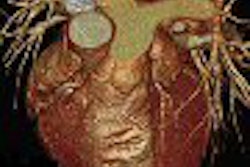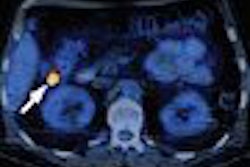To begin our two-part series on avoiding contrast-related nephropathy, Dr. Richard Solomon from the University of Vermont discusses the identification of at-risk patients. In part II, to follow, Solomon will examine procedure-related risk factors, and offer tips on avoiding contrast-induced nephropathy when iodinated contrast imaging is essential for diagnosis.
Radiologists understand the need to keep a wary eye out for contrast-induced nephropathy (CIN), but they're not all aware of critical prevention methods that can minimize the danger in the kidney-compromised patient.
A common cause of kidney failure, CIN results from an ischemic injury to the medullary portion of the kidney secondary to renal vasoconstriction, and from oxidative damage caused by iodinated contrast agents used in imaging. Severe cases can leave the patient dependent on dialysis.
The most important step in avoiding renal failure is identifying the at-risk patient before injecting the contrast, according to Dr. Richard Solomon, who spoke at the 2005 International Symposium on Multidetector-Row CT in San Francisco.
"We're going to talk about how you use serum creatinine as a predictor of renal function," said Solomon, who is a professor of medicine and director of nephrology at the University of Vermont College of Medicine in Burlington. "And the reason behind that is that renal function turns out to be a major risk factor for the development of contrast-induced nephropathy (CIN)."
Creatinine isn't the only way of identifying the at-risk patient, of course. Conditions such as chronic kidney disease, diabetes, volume depletion, hypotension (MAP < 100 mm Hg), nephrotic syndrome, low-output class IV heart failure, and concomitant exposure to neurotoxins other than the contrast agent can all indicate compromised kidneys.
Additional clues to the presence of chronic kidney disease include hypertension, diabetes, age older than 60, family history, nephrotoxic drug exposure, cardiovascular disease, history of acute renal failure, autoimmune disease, urologic disorders, systemic infection, cancer, and, in some cases, even being a member of an ethnic minority. Chronic renal disease can often be seen in the presence of proteinuria, hematuria, and other sediment abnormalities and abnormal blood tests.
But the essential clue is a low glumerial filtration rate (GFR) -- less than 60 mL/min/1.73m2, Solomon said. At this level the risk of chronic kidney disease is approximately 10%, a percentage that increases progressively as GFR falls.
And it is GFR -- not creatinine -- that is the optimal prescan gauge of renal function, he said. The absolute creatinine measurement is by itself unreliable for a number of reasons: its production decreases with age, decreases as muscle mass declines, and decreases as renal function declines. Baseline levels are lower in women than in men, and lower in blacks and Hispanics than whites, Solomon added.
So how does one obtain GFR, which is so rarely measured directly? By measuring the creatinine level and applying a conversion formula that was developed in a trial, he said.
"The MDMR formula was developed by studying people who had chronic, stable kidney disease (and GFR < 55), by measuring their iothalamate levels and GFR simultaneously," Solomon said.
The creatinine/GFR conversion formula is widely available online, such as sites for the National Kidney Disease Education Program, National Kidney Foundation, and Nephron Information Center.
MDMR is quite accurate overall, Solomon said, though it may underestimate GFR (and overestimate the risk of renal failure) in about 30% of patients. Still, taking unnecessary precautions in this subset of patients isn't necessarily a bad thing. The important thing is to use it, he said.
"Now you'll read that women with creatinine over 1.3, men with creatinine greater than 1.5 -- those are the standards that you ought to use in your screening protocols. (But) to identify these high-risk patients I want to dissuade you from using such a standard," Solomon said.
A large number of variables make direct creatinine unreliable for gauging risk. An 80-year-old woman with creatinine of 0.95 (or an 80-year-old man with creatinine of 1.2) has evidence of renal insufficiency, he said.
Radiologists should develop a protocol for identifying high-risk patients, Solomon said before introducing a sample protocol of his own. Extra scrutiny should begin with patients who have diabetes or a history of renal impairment, he noted.
For these patients, consider delaying the imaging procedure, Solomon said. Confer with colleagues and contact the referring physician to establish that it's absolutely necessary. Consider alternatives to iodinated contrast agents -- such as MRI, ultrasound, or CO2 angiography. Measure the creatinine and determine the patient's renal function by calculating GFR.
For patients whose GFR is less than 60 mL/min/1.73 m2 -- or those who have any three of the risk factors below, use preventive imaging strategies:
- Age older than 60
- Diabetes
- Contrast in previous 72 hours
- Congestive heart failure or EF < 45%
- Nephrotic syndrome
- Peripheral vascular disease
- Treatment with NSAID, ACE, diuretic, cyclosporin, tacrolimus, gentamicin, or amphotericin
- Hypertension, hyperurecemia
The sample protocol is his alone, Solomon cautioned: "one person's opinion," and "not based on any official recommendations." But radiologists can and should develop their own approach to minimize the threat of contrast-induced nephropathy, he said.
"Do you need to use contrast? Do you want to use the minimum dose of contrast, or do you want to employ one of these strategies to either inject fast or chase with saline, or do something else that's going to give you the kind of enhancement you want with a minimum amount of contrast?" Solomon asked. "Determine the patient's GFR by using the formula, and if you don't have access to the formula, use any three of the risk criteria (above). The bottom line is, develop your own protocol and be proactive."
By Eric Barnes
AuntMinnie.com staff writer
September 13, 2005
Join us on September 20 for "Part II: Palliative measures prevent contrast-induced nephropathy."
Related Reading
N-acetylcysteine does not prevent contrast-induced nephropathy, June 7, 2005
Iodixanol more cost-effective than iohexol in renal angiography, April 14, 2005
N-acetylcysteine prevents contrast agent-associated nephropathy, September 6, 2004
Sodium bicarbonate may prevent radiocontrast-induced renal injury, May 19, 2004
Radiocontrast-induced nephropathy poses serious risk in patients, study shows, September 3, 2005
Copyright © 2005 AuntMinnie.com




















